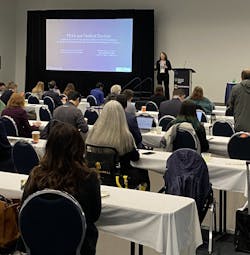MD&M West 2024: Record-setting Rainfall Didn’t Keep Attendees Away from the Monday MiniTec Track
Although the doors to the IME West 2024 Expo opened Tuesday at 10 a.m. PT, there were a slew of sessions from which to choose for conference attendees on Monday.
Co-located with four other show brands—ATX West (automation), WestPack (packaging), D&M West (design) and Plastec West (plastics manufacturing)—under the umbrella of IME West 2024, MD&M West is the annual B2B medical device show that brings together a host of MedTech companies.
Machine Design sat in on the MiniTec track, where the first batch of presentations focused on innovations in resins, surface modifications and processing. This included biodegradable TPUs for tissue repair; microbial susceptibility of various polymers and evaluation of thermoplastic elastomers with antimicrobial additives; and novel bioresorbable polymer composites for medical device applications.
READ MORE: Need Help Mapping Your Show? Planning Tips and Highlights for MD&M West 2024
Despite speakers’ ability to divulge much about their “secret sauces,” in one of DSM’s presentations, they talked about how their proprietary filler silicated ceramic will add osteostimulative and antimicrobial properties to a greater array of strategic partners’ medical devices—provided as a material, manufactured component or licensed medical device—depending on commercial and technical needs, including 3D printing ink.
The segment on the benefits of silicone and the use of surface modifications included presentations on the effects of low-energy electron beam radiation on medical device polymers; extending the capabilities of liquid silicone rubber over-molded polycarbonate; advancements in low-temperature curing liquid silicone rubber; and strategies for surface modification and adhesion enhancement for medical-grade plastics.
After lunch, Maureen Reitman’s keynote kicked off the afternoon, which covered the global impact of PFAS on medical polymers and devices as well as progress updates in sustainability of medical polymers. In her keynote, the consultant and leader in Polymer Technology and Product Development at Exponent, presented about how evolving chemical and environmental regulations on fluoropolymers impact their use in healthcare. The takeaway: We need to find something that works like fluorine but isn’t fluorine.
Speakers from Celanese Corp. and Avient Corp. followed up with presentations on the global impact of PFAS regulatory restrictions on medical plastics and navigating PFAS replacements in the plastics industry.
READ MORE: MD&M West 2024: Brace for a Medical Devices Value Chain Overhaul
The afternoon finished with progress updates in sustainability of medical polymers, which included a presentation by Jennifer Austin from ExxonMobil Prod. Solutions, who talked about advanced recycling and the benefits that it can have. The takeaway here: Manufacturers need to design for recyclability.
Other presentations included the impact of sustainability and sterilization trends on material selection for medical devices; driving towards net zero—a sustainable and circular design approach with homopolymer polyoxymethylene; and finally the challenges and opportunities for recycling of medical plastics.
About the Author
Sharon Spielman
Technical Editor, Machine Design
As Machine Design’s technical editor, Sharon Spielman produces content for the brand’s focus audience—design and multidisciplinary engineers. Her beat includes 3D printing/CAD; mechanical and motion systems, with an emphasis on pneumatics and linear motion; automation; robotics; and CNC machining.
Spielman has more than three decades of experience as a writer and editor for a range of B2B brands, including those that cover machine design; electrical design and manufacturing; interconnection technology; food and beverage manufacturing; process heating and cooling; finishing; and package converting.
Email: [email protected]
LinkedIn: @sharonspielman
Facebook: Machine Design
YouTube: @MachineDesign-EBM




